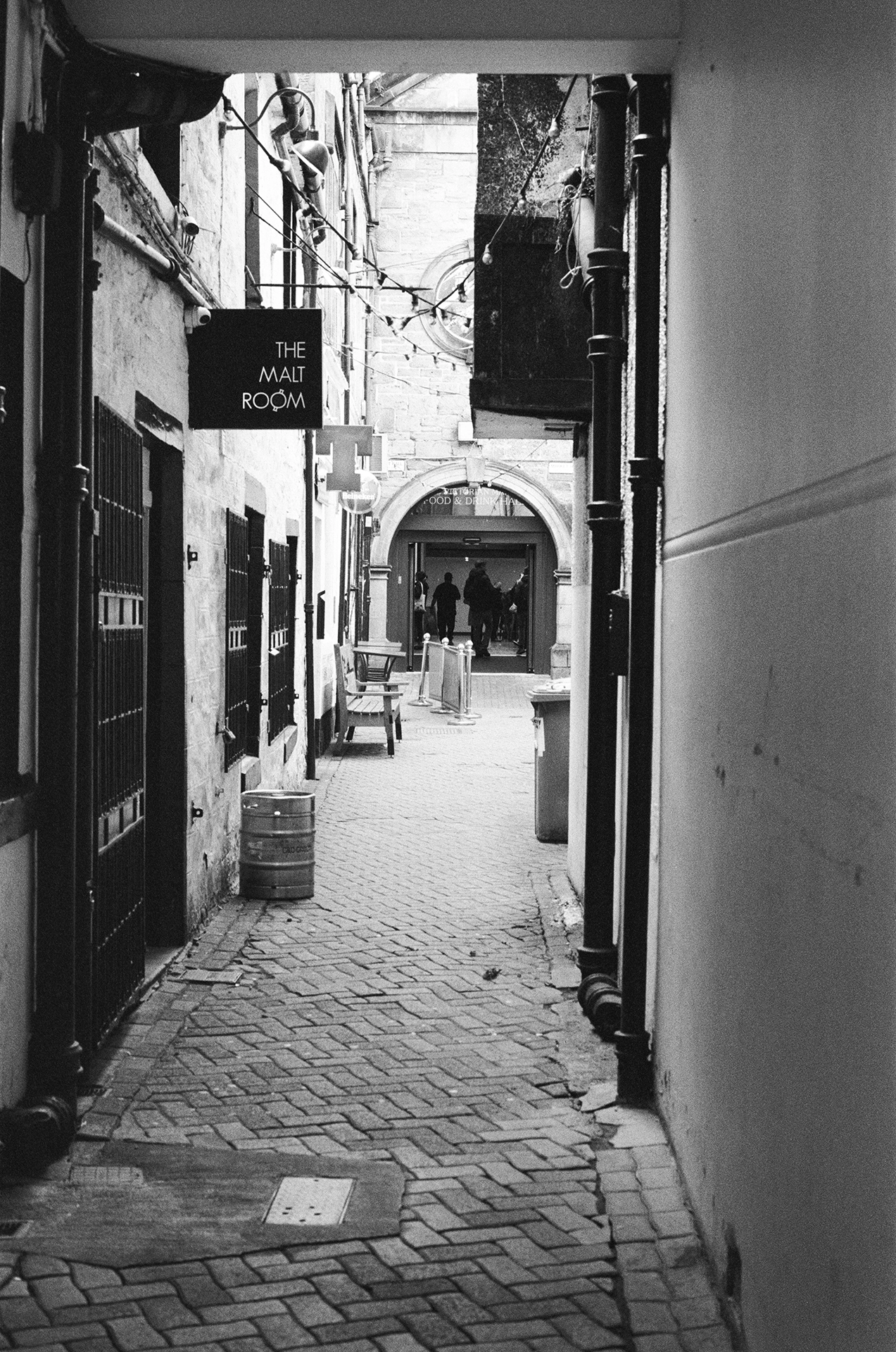
Ilford HP5 Plus 400 Pushed to 800: A Practical and Creative Guide
Ilford HP5 Plus 400 has earned its reputation not through technical perfection, but through forgiveness. It is a film that tolerates uncertainty, adapts to changing light, and rewards photographers who value responsiveness over control. When HP5 is pushed to EI 800, it does not simply become a low-light solution — it becomes a different expressive tool altogether.
Pushing HP5 by one stop subtly reshapes contrast, grain, and tonal separation. Shadows deepen, midtones tighten, and grain becomes part of the visual language rather than a side effect. This guide explores what it really means to push Ilford HP5 Plus 400 to 800, how to expose and develop it reliably, and why many photographers choose to work this way consistently rather than as an occasional experiment.
What does pushing HP5 to 800 actually mean?
When photographers talk about pushing HP5 from ISO 400 to 800, they are describing two separate but connected decisions.
The first decision happens in the camera. The film is deliberately rated at EI 800, meaning it receives one stop less light than box speed. This is intentional underexposure, not a mistake.
The second decision happens during development. Development time is extended to compensate for that lost exposure. This increase in development raises contrast and density, allowing the negatives to print or scan effectively despite the underexposure.
It is important to understand that pushing film does not increase its true sensitivity. HP5 remains a 400-speed emulsion. Pushing is a controlled trade-off: shadow detail is sacrificed in exchange for usable negatives, higher contrast, and a distinctive tonal character.

Why I shoot Ilford HP5+ at 800
There are practical reasons to push HP5 to 800, and there are creative ones. The most obvious is low light. Street photography, interiors, winter landscapes, overcast days, and fast-moving subjects often benefit from the extra stop.
But many photographers continue to shoot HP5 at 800 even when light is plentiful. The reason is aesthetic.
At ISO 800, HP5 develops a firmer tonal structure. Blacks become more confident. Highlights retain their strength. Grain becomes visible but coherent, adding texture rather than noise. For photographers who favour mood, atmosphere, and emotional weight over tonal smoothness, HP5 at 800 often feels more honest than at box speed.
Characteristics of Ilford HP5 Plus 400
Ilford HP5 Plus 400 is a classic cubic-grain black and white film with a long-standing reputation for versatility. It performs reliably across a wide range of lighting conditions and tolerates both overexposure and underexposure better than many modern emulsions.
Key characteristics include:
- Wide exposure latitude
- Strong highlight retention
- Flexible tonal response
- Predictable behaviour when pushed
- Grain that remains organic rather than chaotic
At box speed, HP5 offers a balanced tonal range with moderate contrast. When pushed, that balance shifts — not dramatically, but meaningfully.

How HP5 Changes When Pushed to 800
Pushing HP5 by one stop alters three main aspects of the image: contrast, grain, and shadow detail.
Contrast increases noticeably. Midtones compress slightly, giving images more punch and separation. This can enhance form and structure, particularly in flat or diffuse light.
Grain becomes more visible, especially in midtones and shadows. Rather than appearing random, HP5 grain at 800 tends to form a consistent texture that suits documentary, landscape, and expressive work.
Shadow detail is reduced. Deep shadows may block up, especially if exposure is careless. This is not a flaw — it is part of the aesthetic decision when choosing to push.
Understanding and accepting these changes is essential. HP5 at 800 rewards intentional exposure and punishes hesitation.
Exposure Considerations When Shooting HP5 at 800
When rating HP5 at EI 800, exposure discipline becomes more important.
It is generally wise to expose for the shadows you want to keep. HP5 will tolerate slight overexposure even when pushed, but underexposing beyond the intended stop can quickly result in empty shadows.
Metering strategies that work well include:
- Metering for midtones and allowing shadows to fall naturally
- Avoiding high-contrast scenes where shadow detail is critical
- Using consistent metering rather than reactive compensation

HP5 at 800 is forgiving, but it is not careless.
Development and Processing Considerations
Pushing HP5 requires extended development time. The exact time depends on the developer, dilution, agitation method, and personal taste. The goal is not maximum density, but printable or scannable negatives with clear separation between tones.
Professional labs handle this reliably if clearly instructed. Home development offers more control, particularly over contrast and grain structure.
Ilford HP5 Plus 400 Pushed to 800: Developer Table
The following table outlines typical starting points for developing Ilford HP5 Plus 400 when rated at EI 800. Development times vary depending on agitation style, temperature control, and personal taste, so these should be treated as reference values rather than absolutes.
Development Times for HP5 Plus at EI 800 (20°C / 68°F)
| Developer | Dilution | Time (minutes) | Notes |
|---|---|---|---|
| Ilford ID-11 | 1+1 | ~13–14 | Balanced contrast, classic HP5 tonality |
| Kodak D-76 | 1+1 | ~13–14 | Similar to ID-11, reliable midtones |
| Ilford Microphen | Stock | ~9–10 | Designed for pushing, retains speed |
| Rodinal | 1+25 | ~11–12 | Increased acutance and grain |
| HC-110 | Dilution B | ~8–9 | Strong contrast, clean highlights |
| XTOL | Stock | ~9–10 | Fine grain, good shadow separation |
Notes on development:
- Increase development cautiously; more time quickly increases contrast
- Consistent agitation is more important than absolute time
- Pushed negatives benefit from slightly lower contrast printing or scanning
This table is intended as a practical reference and a foundation for experimentation rather than a fixed recipe.
Scanning should be approached with restraint. Pushed HP5 negatives benefit from gentle contrast adjustments and careful handling of highlights. Overprocessing can quickly strip the film of its natural character.
The Aesthetic of Ilford HP5 at 800
The appeal of HP5 pushed to 800 lies in its emotional tone.
Images tend to feel grounded, direct, and slightly austere. Blacks carry weight. Light feels earned rather than abundant. The grain reminds the viewer that this is a physical process — light interacting with silver, not pixels.

This aesthetic suits:
- Documentary and street photography
- Winter and low-contrast landscapes
- Architectural studies
- Introspective or minimalist work
- Projects concerned with mood and memory
HP5 at 800 is not polite. It is purposeful.

Is Pushing HP5 to 800 Right for You?
Pushing HP5 is not a technical upgrade. It is a philosophical choice.
If your work prioritises smooth tonal transitions, maximum shadow detail, and technical neutrality, box speed may suit you better. If, however, you value responsiveness, atmosphere, and a visible photographic hand, HP5 at 800 can become a long-term companion rather than an occasional trick.
Many photographers discover that once they become comfortable with HP5 pushed to 800, returning to box speed feels less expressive.
Film Results

















Final Thoughts: HP5 at 800 as a Practice, Not a Trick
Ilford HP5 Plus 400 pushed to 800 is best understood as a way of working, not a workaround. It encourages decisiveness in exposure, restraint in processing, and clarity in intent.
Its endurance comes from reliability rather than novelty. HP5 does not surprise — it responds.
For photographers committed to black and white as a medium of expression rather than documentation, HP5 at 800 remains one of the most dependable and expressive choices available.FAQ: Ilford HP5 Plus 400 Pushed to 800
FAQ: Ilford HP5 Plus 400 Pushed to 800
Can Ilford HP5 Plus 400 be pushed to 800?
Yes. Ilford HP5 Plus 400 can be reliably pushed to EI 800 with consistent results. It responds well to extended development, producing higher contrast and more pronounced grain while retaining usable highlight detail.
Does pushing HP5 to 800 increase grain?
Yes. Pushing HP5 by one stop increases visible grain, particularly in midtones and shadows. The grain remains organic and structured, which many photographers consider part of the film’s character rather than a flaw.
Is HP5 at 800 good for low-light photography?
HP5 pushed to 800 is well suited to low-light conditions such as overcast days, interiors, winter landscapes, and street photography. While it does not gain true sensitivity, the combination of underexposure and extended development makes it a practical and expressive option.
Should I expose HP5 at 800 for shadows or highlights?
When pushing HP5 to 800, it is generally best to expose with shadow detail in mind. While highlights are robust, deep shadows can block up if underexposed too aggressively.
Does pushing HP5 to 800 reduce image quality?
Pushing HP5 does not reduce image quality in a technical sense, but it changes the image characteristics. Shadow detail is reduced and grain is increased, while contrast and mood are enhanced. Whether this is desirable depends on artistic intent.
Is HP5 better pushed to 800 or shot at box speed?
Neither approach is objectively better. Box speed offers smoother tonality and finer grain, while EI 800 provides stronger contrast and atmosphere. Many photographers choose one based on the emotional quality they want in their work.
Can HP5 be pushed beyond 800?
Yes. HP5 is commonly pushed to 1600 and even 3200, though each additional stop increases contrast and grain while further reducing shadow detail. These higher push levels suit specific styles rather than general use.
Like what you read? Fuel my next post with a coffee – hit that PayPal button and keep the caffeine flowing!
[wpedon id=77]